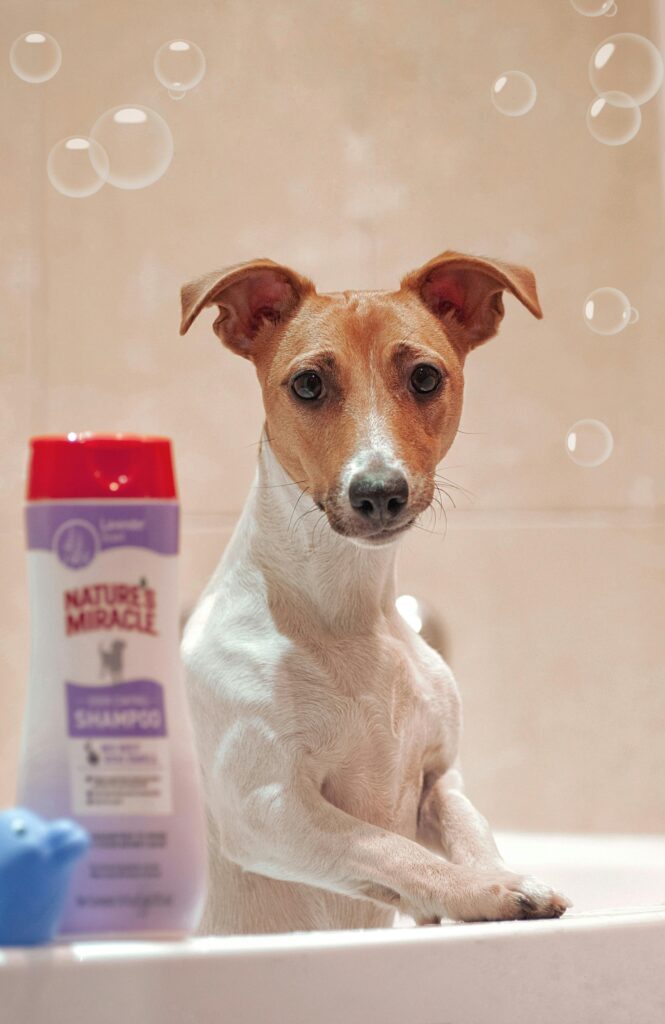More Articles Why Is My Dog Scratching So Much? Dog...
Read MoreIf your dog keeps scratching all the time, it may be a sign of a problem. It is one of the most common concerns for dog owners and a top reason for vet visits. Persistent itching is more than just irritating for your dog. It can indicate allergies, parasites, infections, or other health problems. Left untreated, scratching can lead to open wounds, skin infections, and stress for both you and your pet. The good news is that most causes are treatable once identified, and with the right approach you can restore your dog’s comfort and happiness.
In this article, we’ll cover:

A dog that’s constantly scratching, chewing, or licking is often trying to tell you something is wrong. Occasional itching is completely normal — after all, dogs explore the world with their noses, paws, and fur, which exposes them to dust, pollen, and tiny irritants every day. But when the scratching becomes constant or intense, it’s often a sign that something more serious is going on.
Excessive itching, also called pruritus, is one of the most common reasons dog owners visit the vet. It can be caused by a variety of issues — from fleas and environmental allergens to skin infections, food sensitivities, hormonal changes, or even stress. In some cases, a single flea bite can trigger days of discomfort, while in others, a hidden allergy can cause year-round symptoms.
Left untreated, persistent scratching can do more than just annoy your dog. It can break the skin, leading to painful hot spots, bacterial or yeast infections, and hair loss. Over time, the constant irritation can affect your dog’s sleep, energy levels, and overall quality of life — and may even cause behavioral changes such as irritability or aggression.
The good news is that most causes of itching are treatable once identified. With a little detective work, you and your veterinarian can pinpoint the root cause and create a plan that relieves your dog’s discomfort and prevents future flare-ups.
In this guide, we’ll explore the most common reasons dogs scratch excessively, how to tell the difference between mild and serious cases, and what you can do to keep your dog’s skin healthy and itch-free. Whether it’s a seasonal pollen problem, an unwelcome parasite, or an overlooked skin condition, understanding the “why” is the first step toward giving your dog lasting relief.
Even a single flea bite can cause intense itching, especially in dogs allergic to flea saliva. This condition, called flea allergy dermatitis, can cause days of discomfort after just one bite. Fleas tend to hide in warm, protected areas such as the base of the tail, belly, armpits, and neck.
Signs: Red bumps, hair loss, constant scratching or biting, and the presence of flea dirt (tiny black specks in the fur).
Other parasites like mites (mange), ticks, and lice can also cause severe itching. Mange mites can lead to crusty skin and hair loss, ticks may transmit dangerous diseases, and lice can spread quickly between dogs.
Example: Bella, a 4-year-old Beagle, scratched her ears raw after catching ear mites from playing with a neighbor’s outdoor cat. Regular parasite prevention and routine checks kept her itch-free afterward.
Triggers: Pollen, mold spores, dust mites, and certain grasses.
Signs: Itchy paws, red ears, inflamed belly, watery eyes, frequent licking after walks.
Management: Wipe your dog’s paws and coat after walks. In severe cases, your vet may recommend antihistamines or allergy shots.
Example 1: Max, a Labrador, scratched every spring due to pollen. Antihistamines plus daily paw cleaning reduced his symptoms.
Example 2: Sophie, a Cocker Spaniel, developed constant red paws in summer from grass pollen. Switching walk times to late evenings and rinsing her paws after walks solved the problem.
Common triggers: Beef, chicken, dairy, wheat, soy, eggs.
Signs: Year-round itching, chronic ear infections, digestive upset.
Management: A vet-supervised elimination diet; once the allergen is identified, it must be avoided completely.
Example 1: Bruno, a German Shepherd, stopped developing hot spots after chicken was removed from his diet.
Example 2: Daisy, a French Bulldog, overcame diarrhea and itchy skin after switching to a fish-based hypoallergenic diet.
Causes: Shampoos, detergents, cleaning products, synthetic fabrics, bedding.
Signs: Localized redness or rash in areas that touch the allergen.
Management: Remove the trigger; use hypoallergenic bedding and pet-safe cleaners.
Example 1: Bella, a small Terrier, developed red bumps on her belly from lying on a blanket washed with scented detergent. Switching to fragrance-free detergent resolved the issue.
Common in winter due to low humidity, but can also result from poor nutrition, dehydration, or frequent bathing with harsh shampoos.
Signs: Flaky dandruff, dull coat, mild redness.
Care: Add omega-3s (fish oil, flaxseed) to the diet, use a humidifier, choose moisturizing dog shampoos, and avoid overbathing.
Example 1: Lucy, a Golden Retriever, saw her winter dandruff disappear after salmon oil was added to her meals.
Example 2: Milo, a short-haired Dachshund, developed dry, flaky skin from daily baths. Reducing baths and using a moisturizing shampoo restored his coat.
Scratching can break the skin barrier, allowing bacteria or yeast to grow. Dogs with skin folds or moist areas are at higher risk.
Signs: Redness, swelling, hot spots, foul odor, greasy coat.
Treatment: Vet-prescribed medicated shampoos, antifungals, or antibiotics. Keep skin folds clean and dry.
Example 1: Rocky, a French Bulldog, cleared a yeast infection in his folds after targeted antifungal care.
Example 2: Lola, a Shih Tzu, had repeated bacterial infections under her tail due to trapped moisture. Daily cleaning and a vet-prescribed ointment solved the problem.
Conditions such as hypothyroidism or Cushing’s disease can impact skin health and hair growth.
Signs: Symmetrical hair loss, darkened skin, weight changes, lethargy.
Care: Diagnosis via blood tests, followed by medication and ongoing monitoring.
Example 1: Bella, a senior Beagle, regained her coat after starting thyroid medication.
Example 2: Cooper, a Poodle mix with Cushing’s, stopped losing hair once he began vet-prescribed treatment.
Stress, boredom, or anxiety can lead to compulsive licking and scratching — a condition known as psychogenic itching.
Example 1: Charlie, a Border Collie, stopped paw licking after getting more exercise, engaging in toys, and calming supplements.
Example 2: Luna, an adopted Greyhound, chewed her tail from separation anxiety. Daily puzzle feeders and gradual alone-time training helped her stop.

Dogs with seasonal allergies often experience flare-ups during certain times of the year when environmental allergens are at their peak. Unlike food allergies, which cause symptoms year-round, seasonal allergies tend to appear and disappear depending on the season, often worsening if left unmanaged. These allergies are typically triggered by substances such as pollen, mold spores, grass seeds, and insect bites. Dogs may show symptoms like excessive paw licking, scratching specific areas, watery eyes, sneezing, or developing red patches on the skin. Seasonal allergies can also weaken the skin’s natural barrier, making it more prone to secondary infections if the itching causes small wounds or abrasions.
Spring:
Pollen from blooming trees, flowers, and grasses is one of the most common triggers during spring. These microscopic particles stick to a dog’s fur, paws, and skin, causing itchiness, redness, and swelling. Dogs may scratch their paws and belly after walks, develop red, watery eyes, sneeze more frequently, or lick themselves excessively after being outdoors. In severe cases, skin rashes can appear within hours of exposure.
Example: Bella, a Border Collie, began licking her front paws every evening in spring. Her owner started wiping her down after walks and using an air purifier, which significantly reduced her symptoms.
Summer:
Insects such as fleas, mosquitoes, and biting flies are at peak activity during summer. Even a single flea bite can trigger intense itching in sensitive dogs, leading to days of discomfort. Mosquito bites can cause localized swelling, redness, and discomfort that may last for hours or even days, especially in short-haired breeds. Dogs who spend more time swimming or lying on damp ground can also develop “hot spots” — inflamed, infected patches caused by moisture and scratching.
Example: Rocky, a Labrador, developed red bumps on his belly after spending afternoons in tall grass. Switching to a flea preventive and avoiding high-risk areas stopped the flare-ups.
Autumn:
Fallen leaves and damp conditions increase mold spore levels, which can cause skin irritation, sneezing, and runny eyes. Dogs may also encounter more mites, particularly in piles of leaves or unkempt gardens. Because the weather is cooler, owners sometimes reduce grooming frequency, allowing allergens to build up on the coat.
Example: Milo, a Beagle, developed red skin on his chest every fall. His vet identified mold spores as the cause, and weekly medicated baths kept the itching under control.
Winter:
Indoor heating reduces humidity, leading to dry skin, increased flaking, and itchiness. In some regions, stored dust and mold in heating ducts can also worsen symptoms, particularly in dogs prone to respiratory irritation. Without regular moisturizing care, dogs with naturally sensitive skin may experience cracking and redness.
Example: Daisy, a short-haired Terrier, developed dandruff every winter. Her owner added salmon oil to her diet and used a humidifier indoors, which eliminated the problem.
Prevention Tips:
Wipe your dog’s paws, legs, and belly with a damp cloth or pet-safe wipes after outdoor walks to remove pollen, grass seeds, and other allergens that can cling to the fur. This simple habit can significantly reduce flare-ups.
Use air purifiers with HEPA filters in rooms where your dog spends the most time to reduce indoor allergen levels.
Keep bedding, blankets, and washable toys clean by washing them weekly in hot water to kill dust mites and remove pollen.
Avoid walking during peak pollen times, usually early morning and late evening in spring and summer. On high-pollen days, opt for shorter walks or indoor play.
Extra Tip: Keeping a detailed symptom log is extremely helpful. Record scratching intensity, visible skin changes, weather conditions, outdoor locations, and diet changes. Over time, these notes can reveal clear patterns, helping you and your vet pinpoint triggers and create a more targeted prevention plan.


While mild, short-term scratching can often be managed at home, there are situations where professional veterinary attention is essential. Persistent or severe itching can signal an underlying condition that will not resolve without proper diagnosis and treatment.
Call your vet if:
Other warning signs include a foul odor from the skin or ears, excessive licking of the same spot, thickened or darkened skin, swelling, or sudden hair loss. If your dog is shaking their head or scratching their ears excessively, it could be an ear infection, which can worsen quickly without treatment.
Your veterinarian may recommend diagnostic tests such as skin scrapings, fungal cultures, allergy testing, or blood work to determine the cause. Early intervention not only speeds recovery but also prevents further complications. Prompt veterinary care ensures your dog gets the right treatment—whether it’s medication, dietary adjustments, or parasite control—so they can return to a comfortable, itch-free life.

Yes. Stress can lead to compulsive licking or scratching, known as psychogenic itching. Increasing mental stimulation and reducing stress triggers can help.
Only after consulting a vet and considering an elimination diet. Sudden diet changes can upset digestion.
Only under veterinary guidance. Dosage and safety depend on your dog’s size, breed, and health condition.
It may be a reaction to shampoo or grooming products. Switch to hypoallergenic, fragrance-free formulas.
No. Overbathing can strip essential oils, causing dryness. Bathe every 3–4 weeks unless advised otherwise.
No. Parasites, infections, dry skin, and hormonal imbalances are also common causes.
Yes. Dry winter air and high pollen in spring can both trigger symptoms.
Yes, if food allergies are suspected, but only with vet supervision to ensure nutritional balance.
Some can soothe skin, but many are toxic to dogs. Always ask your vet first.
Possible causes include fleas, mites, nighttime allergens, or anxiety. A vet check can identify the cause.

Excessive scratching should never be ignored, as it is often your dog’s way of signaling discomfort or distress. While an occasional itch is normal, persistent scratching, chewing, or licking can quickly lead to skin damage, open sores, and secondary infections. The underlying causes can range from something as simple as dry skin to more complex issues like allergies, parasites, or hormonal imbalances.
The first step to solving the problem is careful observation. Pay attention to when the scratching happens, how long it lasts, and whether it’s accompanied by other symptoms such as hair loss, redness, swelling, or changes in behavior. Keeping a log of your dog’s symptoms, diet, grooming schedule, and environmental conditions can be invaluable in identifying patterns and potential triggers.
Prevention is always easier than treatment. Regular grooming, a balanced diet rich in skin-supporting nutrients, year-round parasite protection, and maintaining a clean home environment can go a long way toward reducing the risk of itching. Seasonal allergy management—such as wiping down your dog after outdoor activities, using HEPA filters indoors, and avoiding peak pollen hours—can also help sensitive dogs.
When scratching becomes persistent or severe, professional veterinary care is essential. A vet can perform skin scrapings, allergy tests, blood work, and other diagnostics to pinpoint the exact cause. Early intervention not only provides relief for your dog but also prevents the problem from escalating into something more serious.
It is also important to remember that scratching is not always caused by physical conditions. Stress, boredom, and anxiety can manifest in excessive grooming behaviors. Providing your dog with mental stimulation, regular exercise, and a stable routine can improve overall well-being and reduce stress-related scratching.
Ultimately, your goal is to keep your dog comfortable, healthy, and happy. By staying proactive, addressing issues promptly, and working closely with your veterinarian, you can ensure your furry friend enjoys an itch-free, tail-wagging life.

Adopt Smart
More Articles Why Is My Dog Scratching So Much? Dog...
Read MoreAugust 12, 2025 9:10 pm Does your dog seem itchy...
Read MoreEmpowering dog owners with proven solutions for allergies, nutrition & overall dog health.
© Copyright 2025 My PupEase –
All Rights Reserved.